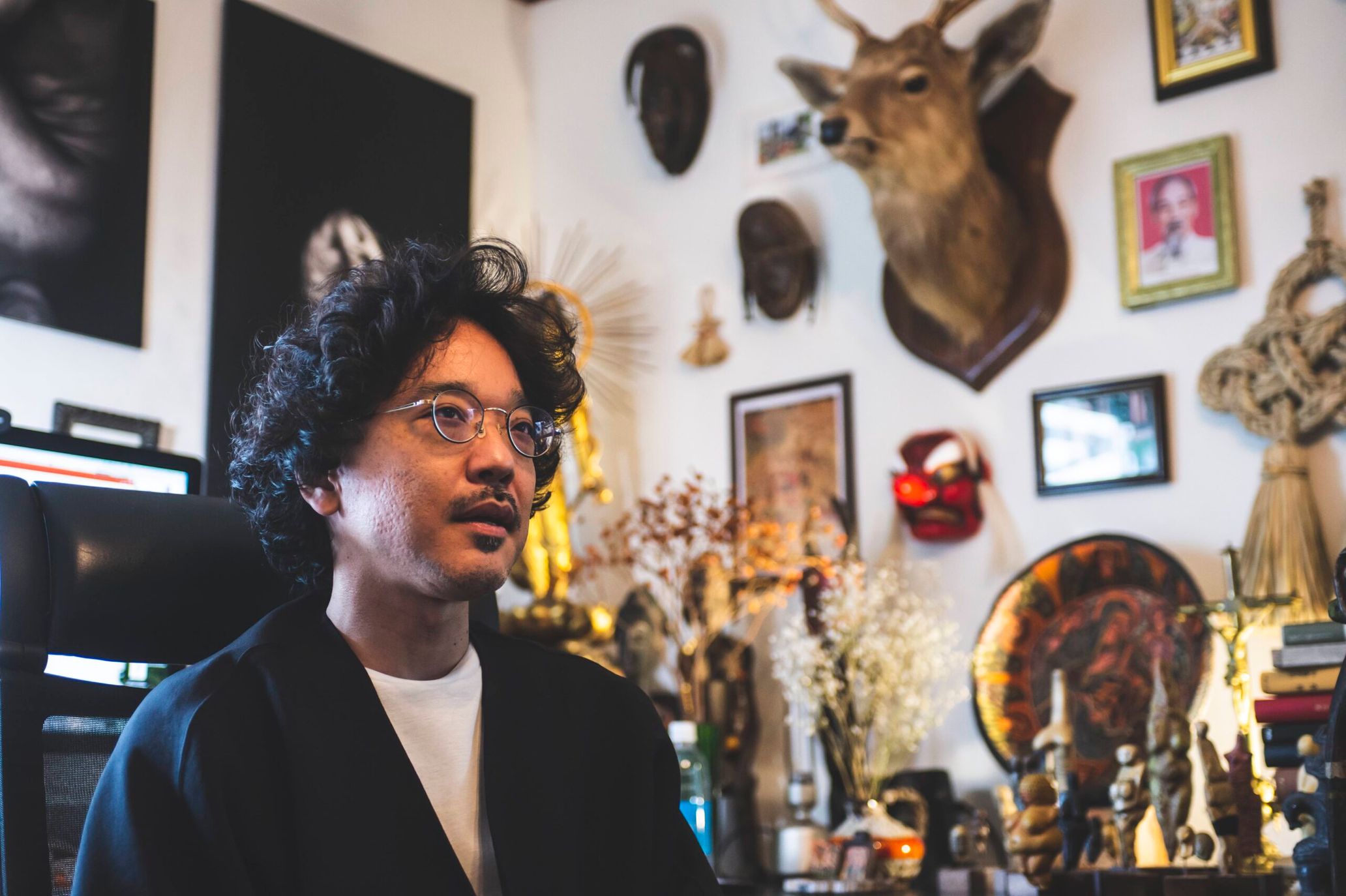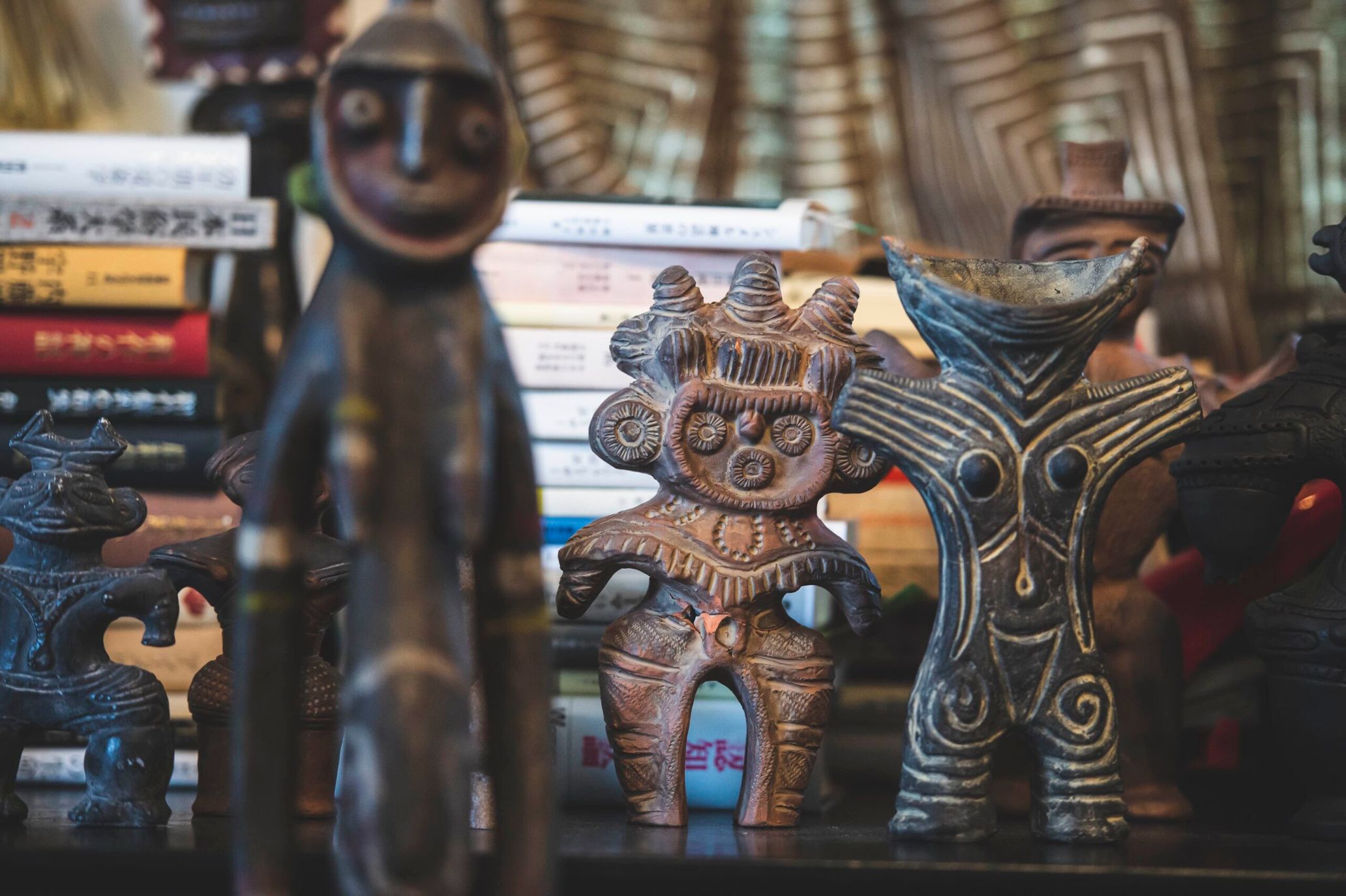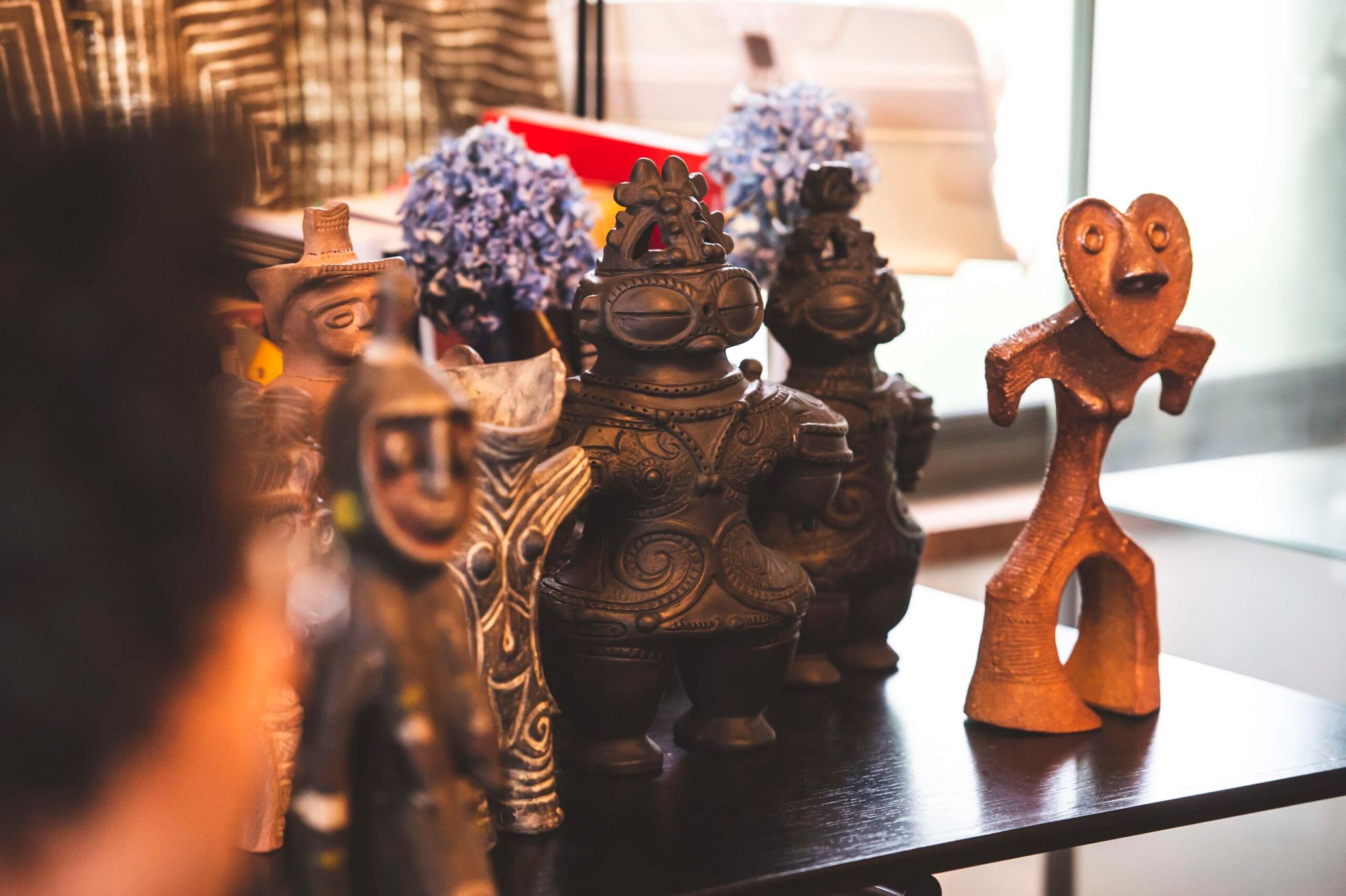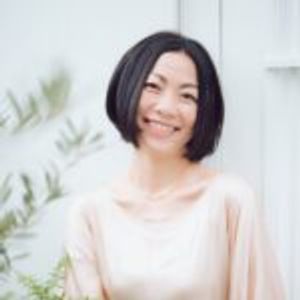The theme of this series is to understand Japanese “intentions” through people, community, and events, and reconsider the true nature of Japanese culture in any field. This issue features anthropologist Fumito Takekura, author of 土偶を読む(Reading Dogū).

In recent years, people’s interest in the Jomon period has been increasing: the special exhibition Jomon:10,000 Years of Prehistoric Art in Japan at the Tokyo National Museum in 2018 was unprecedentedly popular, attracting more than 300,000 visitors. The Jomon cluture has been introduced in TV programs for both domestic and international audiences, and it is still fresh in our minds that in 2021, the Jomon Prehistoric Sites in Northern Japan was registered as a UNESCO World Heritage Site.
Perhaps the most beloved Jomon artifact is Dogū (Dogū literally means earthen figure in Japanese), small humanoid and animal figurines made of clay. Their unparalleled forms attract many people, and some have fetched hundreds of millions of dollars at auctions. One person has had an explosive impact on the world of Dogū. He is anthropologist Fumito Takekura, who last year published a book providing a novel perspective on Dogū titled 土偶を読む(Reading Dogū: 2021).
In his bestseller土偶を読む, which won both the Suntory Prize for Social Science and Humanities and the Jun Miura Prize, Takekura stands squarely against the conventional belief that Dogū represents female figure, especially pregnant female. He proposed a completely new view that Dogū is figurine in the shape of plant spirits. He formulated a hypothesis from the viewpoint of iconology, asking what exactly these earthen figures resemble, and tested the hypothesis through fieldwork and empirical data from various parts of Japan. He literally deciphered the motifs of various Dogū. The highly persuasive hypotheses he develops based on a frank sense of discomfort with common-sense understanding are highly acclaimed even in academic circles, and are accepted by many readers as a fresh solution to a mystery.
We asked Takekura, who spent several years looking closely at and even sleeping with Dogū for his research, why people are so fascinated with the Jomon period. To begin with, he said, the Jomon period was an entity sometimes excluded from Japanese history.


The concept of a myriad of deities is connected to the Jomon Animism
“In fact, it was only recently, after World War II, that the Jomon period came to be regarded as a commonplace historical periodization. Until then, it was called the “Stone Age” along with the Yayoi period, and was not part of authentic Japanese history as described in the Kojiki and Nihonshoki, oldest and second-oldest book of Japanese ancient history. It is only recently that the details of the Jomon culture have become clear. With the land developments during the period of rapid economic growth, ruins from Jomon period were discovered and large quantities of artifacts were unearthed all over Japan. In the 1990s, excavations at the Sannai-Maruyama site in Aomori Prefecture revealed that the Jomon had advanced techniques in lacquer craft and civil engineering. In recent years, the use of electron microscopes has become popular, and microscopic artifacts have revealed that people in the Jomon were engaged in the cultivation of plants. Besides, advances in DNA analysis in the field of molecular biology have also revealed that some Japanese have inherited the blood of the Jomon people. As these various discoveries accumulated, our perception of the Jomon people completely changed from ‘a barbaric indigenous people of the Stone Age’ to ‘our ancestors with a rich culture’. It is now more natural to include the Jomon period in “Japanese history,” and the existence of the underlying Jomon culture cannot be ignored when discussing Japanese culture. In fact, the origin of the Japanese mindset of carefully conducting “funerals for tools,” such as the “memorial services for needle and brush” that are still practiced in many places today, may be traced back to the Jomon period, and the concept of a myriad of deities is also connected to Jomon Animism. In other words, it is no exaggeration to say that the essence of the Jomon culture has been handed down from generation to generation in Japanese culture. Above all, the simplicity and striking characteristic of Dogū and earthenware is their formative appeal, which I think is very significant (in terms of their popularity.) “
Based on animism, a belief in nature that pays respect to even flowers and plants in the field, the people were feeding themselves by gathering, cultivating, hunting, and fishing. The Jomon people are said to have had no great disparities. The system is totally different from the modern society we live in. That is why Japanese people become attached to them when they realize that fragments of their ancient past are inside themselves. Among them, the uniquely designed Dogū have become a symbolic presence. Takekura says that their formative appeal, which requires no explanation, “makes them valuable enough to be used as a tourist resource. However, as a figure of a “plant spirit,” it will take some time before it can assume the role of a tourist ambassadors that yuru-chara currently assume. This is because many people involved in archaeology do not want to accept Takekura’s new theory. It is not surprising, of course, that they would not so readily retract their own theory, which they have been advocating for so many years.
However, many of Dogū do not resemble human female figures, and it is much more natural to assume, as Takekura points out, that there are different motifs for different style of Dogū. This is probably the reason why his book became a bestseller and is supported by many readers. On the other hand, it is also true that there are people who dispute the new theories, such as the one proposed by Takekura, while they themselves simply repeat the conventional, ambiguous “common theories.” Many people may feel uncomfortable with this kind of situation in the academic world. Takekura points out that such old-fashioned reactions are caused by the monopolization of intellectual resources by male researchers.
Takekura says, “As with Jomon earthenware, I believe that many of Dogū were made by women. The motifs of them are plants and shells because they are related to women’s occupation, such as cultivation and gathering. In other words, Dogū were tools for women’s livelihood. But look at the researchers we had so far. Most of them are men. Men mystify Dogū and project their desires onto them, or, on the contrary, they are satisfied with cataloguing them in a bureaucratic manner by thoroughly objectifying them. These are exactly the typical romanticism and fetishism toward Dogū that men would do. Criticism of my research results is fine, but if they have time to do that, I would like them to review how good their own research on Dogū is, which they have done using taxpayer money. By the way, I am an independent researcher, so I pay for everything myself (laughs). In any case, the Dogū, which have gone from being ancient “women’s tools” to modern “men’s tools,” are a perfect symbol of the evils of modern academia, social institutions, and intellect designed around men.”
Talking about Dogū is also about rethinking gender issues!
Recent research has shown that the Jomon were far more dependent on plant-based resources than once assumed. Takekura says, “we think that in terms of food procurement, men were primarily responsible for hunting and fishing while women were taking the lead in plant gathering, cultivation, and tide-pooling.” In other words, an important part of food procurement depended on women. It would be unnatural that such a Jomon period has been studied exclusively by men. Takekura also feels that paternalistic authoritarianism still prevails in the academic world, and he feels the limitations of studying within a system.
He continues, “I started my research because I was so attracted to Dogū, but I am not a specialist in archaeology. The idea that Dogū need to be researched within a field of archaeology is a thing of the past. A Dogū is a Dogū, and you are free to think about it in any way you like. A subject to be researched does not exist for professional scholars in a certain field of expertise. It is the opposite. The true form of scholarship should be to have a research subject and to challenge it using one’s holistic intellect and liberal arts”. Takekura, whose own book has attracted lots of attention and whose 土偶を読む図鑑(Illustrated Guide to the Interpretation of Dogū) was published in April, says he has no intention of becoming a “researcher of Dogū.” So, what is his main field? The emphasis of his practice is not on the academic world of researchers, but on the essence of learning and intelligence, which is common to all people.

“Intellect is something exciting and fun, born out of the desire to know more”
“After dropping out of Musashino Art University and spending free time away from study, I entered the University of Tokyo’s Department of Humanities III and graduated with a degree in religious study. At that time, I already felt a gap between what I wanted to do and know and what was actually being done in academia. For me, academia is merely a tool. But there was an abundance of studies for the sake of studies, or studies that is an end in themselves. I was not comfortable with those kinds of things. However, by daring to continue doing something that doesn’t fit you, you can occasionally create unpredictable chemical reactions. For various reasons, I spent nearly nine years in the graduate school of Tokyo Institute of Technology in my thirties, and I think that something within me was really strengthened while I was hiding in the huge organization of the university. At that time, I felt like a Vietcong member (laughs). “
The Vietcong is an anti-imperialist liberation front during the Vietnam War that originated from a series of protests against government oppression with stag and sickle in protesters’ hands. He was hiding in the jungle of everlasting student life, vigilantly setting his sight on the academic authority that can be compared to then authoritarian government and the U.S. military that stood behind them, and the arrows he fired reached Dogū from the Jomon period.
“My methodology, which starts from thinking intuitively about what a Dogū looks like, is an approach that has long been neglected in archaeology. They must have thought that my approach was “just an idea” and that they scholars are doing a nobler, more respectable study. I have been thinking about how to destroy this kind of authoritarianism, which looks rather ridiculous in my view, and which is so far removed from the way we live our lives. Learning and intellect are not the exclusive domain of so-called “experts,” much less of those who flaunt their authority under the umbrella of their titles. Intelligence is an exciting and enjoyable thing that is born from a simpler and more expansive curiosity, and no matter how advanced study becomes, that is the basic principle to which we will always return. I would like to continue to refine the free intellect that is not entangled in authority or social systems, but is inherent in human.”
People tend to feel comfortable with things that have a fixed genre or category. In Takekura’s case, if he is studying Dogū, we can comfortably perceive his practices as long as we can recognize him as an expert on Dogū or the Jomon period. However, he does not aim at becoming an expert on Dogū, as can be seen from his previous book, which was about metempsychosis. What, then, is his theme? It is to free the intellect from the cage of authority and make it exciting and enriching entity that it was originally meant to be. In other words, it is what we can call academic liberation and intellectual liberation.
He is a unique figure who advocates the true beauty and freedom of study from the standpoint of an independent researcher who does not belong to any research institution or academic society. What is our “common sense” understanding that will be overturned after the one on Dogū? Since the pandemic, a number of new values have been born. But what will be created when knowledge gains new freedom? I believe that this will be something exciting not only for the academic world but also for society as a whole.

Fumito Takekura
Fumito Takekura is an anthropologist and independent researcher born in 1976. After dropping out of Musashino Art University and graduating from the University of Tokyo, he went on to complete a doctorate at the Tokyo Institute of Technology. His publications include 輪廻転生(Metempsychosis, 2015), 土偶を読む (Reading Dogū, 2021), and 土偶を読む図鑑 (Illustrated Guide to Reading Dogū, 2022).
Photography Kunihisa Kobayashi
Translation Shinichiro Sato(TOKION)

